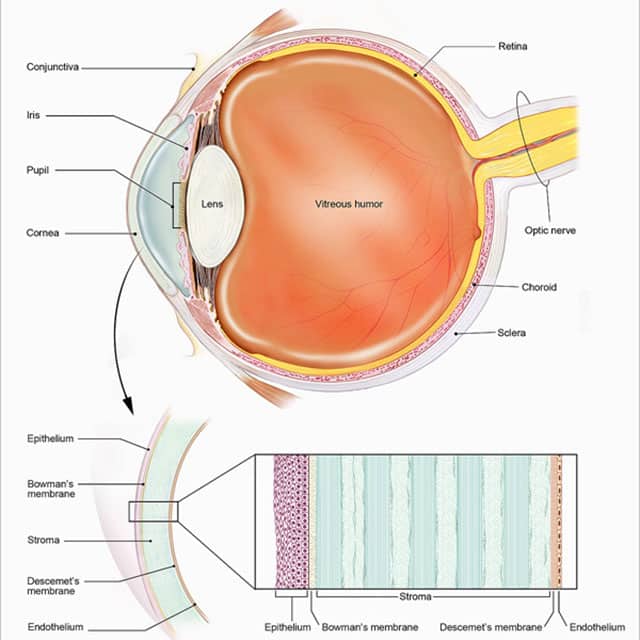What is the cornea?
The cornea is the clear, dome-shaped covering over the colored part of the eye. Comparable to a windshield, the cornea provides a barrier to protect the eye from dirt, germs, and other particles.
The cornea is a highly organized tissue, however unlike most tissues in the body, the cornea contains no blood vessels. It is nourished by tears on the outside and the aqueous humor on the inside.
The tissues of the cornea are arranged in five layers

1. The epithelium is the outermost layer of the cornea.
The epithelium’s primary function is to protect the eye from dust, water, bacteria, and other foreign materials. It also absorbs and distributes oxygen and nutrients from tears to the other layers of the cornea. If the corneal epithelium is damaged by an abrasion or foreign body it can regenerate in about 24 hours without scarring. It is one of the fastest healing tissues in the body.
2. The Bowman’s layer is a translucent film of tissue made of collagen protein fibers.
The Bowman’s layer is highly resistant to penetration or damage. However, if injury should occur, scarring could negatively affect vision.
3. The stroma is the thickest layer of the cornea made up of collagen and a porous, hydrated gel.
The fibers extend across the entire cornea in parallel arrangements. The arrangement and shape of these fibers in the stromal layer give the cornea its strength, elasticity, and perfect clarity.
4. The Descemet’s (DESS-eh-mays) membrane is composed of collagen fibers (different from the stroma) in the anterior lamina that give the layer its elastic properties.
The posterior lamina is constantly secreted by the endothelium and gradually thickens into adulthood. The Descemet’s membrane is highly resistant to damage, but can regenerate if injured.
5. The innermost layer of the cornea is the endothelium.
The endothelium’s primary function is to regulate the fluid at the posterior surface of the eye to keep the cornea clear. The cells of the endothelium cannot regenerate. If cells are destroyed, the remaining cells spread out to fill the spaces causing fluid to accumulate. If there is a build up of fluid, the cornea can swell and become opaque causing decreased vision.
What are the functions of the cornea?
The transparent cornea helps focus light that enters the eye. It is responsible for 65-75 percent of the focusing power. The lens, located behind the pupil, focuses the remainder of the light onto the retina, which starts to transform the light into vision.
The cornea also filters harmful ultraviolet (UV) rays from the sun.
If the cornea has an irregular shape or symmetry it can cause refractive errors like nearsightedness, farsightedness, and astigmatism.
